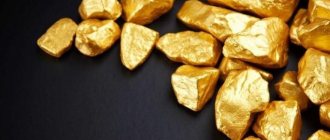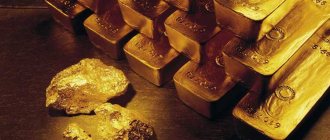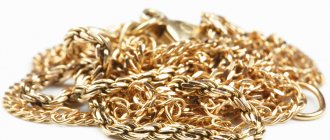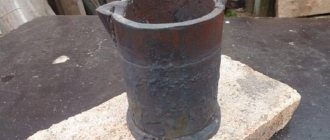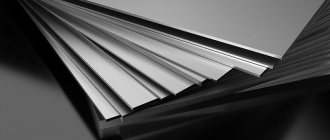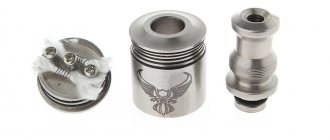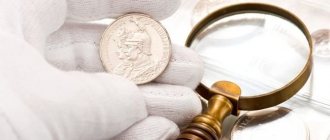Silver is the most common precious metal. It is white in color and has fairly high ductility, making it easy to forge. It has reflective qualities, which makes it in demand in industry for the production of reflective surfaces. The density of silver in its pure form is 10.5 g per cubic centimeter. It is very resistant to corrosion.
Being in nature
Silver is 65th in abundance among the elements found in the earth's crust. It is the most common of precious metals. The silver content in the earth's crust is approximately 0.075 g per ton of rock. This figure is 20 times greater when compared with gold or platinum. Silver is found in different quantities in different places. Typically this value varies between 0.05−1 grams per ton.
But various geological processes can also occur that increase the concentration of white metal to 1 kg per ton of rock. For example, there is a deposit called “Goltsovoye”. It is located in the Magadan region. In this mine, the concentration of silver reaches 1.2 kg per ton.
The precious metal can also be found in sea water, where its amount is an order of magnitude higher than gold. On average, this value is 0.00004 g per cubic meter.
The chemical activity of the material makes it quite difficult to find in its pure form. But there have been cases in history when people found truly huge nuggets. In 1894, the largest piece of silver was found in Colorado, which weighed 1065 kg. After melting, it was possible to obtain 835 kg of pure substance. Today it would be worth more than half a million US dollars.
There are almost 60 minerals in nature that contain silver. Often this element is included in sulfide ores of zinc, antimony, bismuth, copper and lead. Also, metal is always present in gold ores.
Metal density
Silver, the density of which determines the composition of the alloy components and the melting point and varies depending on the environment and measurement conditions, is a precious metal. The density value corresponding to 10.49 g/cm³ is considered to be the standard for the specific gravity of the lunar component without impurities.
Silver, along with other noble chemical elements, forms nuggets that are distinguished by their chemical purity. For example, in 1477, a native formation weighing 20 tons was discovered at the St. George mine (45 km from the city of Freiberg in Germany).
Nugget from a mine in Germany.
In Denmark, the museum houses a nugget weighing 254 kg, discovered at the Kongsberg mine in Norway. Pure native silver has been found on other continents. In Canada, during the development of the deposit, plate formations with a total weight of 612 kg were recovered.
Considering the density of the chemical element, native formations, so impressive in weight, occupy a small volume. The weight of a cube with a side of 1 m made of silver is 10490 kg.
In practice, various compounds of a chemical element with other components are used, imparting new properties and improving the physical and technical parameters of the noble composition.
A group of metals is characterized by certain physical and technical parameters and properties that determine their specific gravity. In the jewelry industry, this indicator is calculated to determine the suitability of alloys for the production of products.
It is the value of the density indicator that characterizes the weight of the compound per unit volume, and its calculation is carried out in order to determine the proportion of ligature components in the composition.
The specific gravity of a noble component is defined as the ratio of mass to volume and is measured in kg/m³ or g/cm³. General indicators are found in reference books, and to calculate the weight of chemical element No. 47, a formula is used that multiplies the actual volume by the reference value.
World deposits
Silver is mined from fundamentally different types of deposits. There are only two such types. They are divided as follows:
- Directly silver deposits. If you process all the mined ore, then more than 50% of the cost of all elements will be allocated to silver.
- Deposits where polymetallic ores are mined. The extracted rock contains several metals at once. Among them, silver accounts for no more than 15% of the total final price.
The world receives only 25% of silver from the first type of deposits. The rest is mined from polymetallic rocks. In them, the production of this precious metal is a by-product. Such ores include:
- nickel;
- copper;
- gold;
- cobalt;
- lead-zinc.
All silver production processes associated with mining, processing and isolation are very similar to gold. After the ore is extracted and prepared, a concentrate is produced using cyanidation. Pure metal comes out of refineries.
Mexico remains the leader in silver mining. Then comes China, which continues to increase production every year.
Physical properties of silver
The density of 925 is 10.36 g/cm3, that is, the density of silver in kg per m3 is 10360. This metal is quite difficult to melt and is very ductile. From 1 kg you can make a wire whose length will be 2 km. When exposed to oxygen, the metal does not oxidize, which is why it is considered noble. But it reacts with iodine and sulfur, which is why a dark film gradually appears on the surface, so jewelry must be constantly looked after.
Metal is very easy to process. It can be easily rolled out, drawn out, polished and cut. Jewelers like these qualities, but they negatively affect the longevity of the product. It is not used in its pure form, but is alloyed with copper.
Sterling silver is 925. It is almost pure with very little copper added. It is used in jewelry and for the production of tableware.
In its pure form it is a very heavy metal. The specific gravity of 925 silver is 107.87 a. e.m. It is a superconductor of electricity and heat. Basic properties:
- It has the lowest melting point when compared with other precious metals.
- Dissolves only in mercury, nitric and sulfuric acid.
- Does not react with substances.
- It cannot be dissolved in aqua regia.
Let's sum it up
People always ask me how to tell if silver is real or fake. After reading this review, you learned, dear readers, that silver is extremely thermally conductive, so you can use a simple method - put it in boiling water (if the product does not have stones). It will heat up instantly, but will cool down just as quickly, unlike a fake.
This is important to know, since you should only buy real, high-quality products.
Silver alloys are in demand both in the jewelry industry and in medicine due to their antimicrobial effect; in nanotechnology, in microelectronics (don’t forget that this metal is an excellent conductor). This is a natural, exhaustible resource with a lot of special properties. Share this information on social networks, subscribe to us to learn new and useful information. See you soon!
Alloys and samples
An alloy is a mixture of pure silver and some other metals. This is done to improve the required characteristics. Each state regulates the permitted amount of impurities and their types for each sample.
Features of various alloys:
- 960 sample. Almost pure metal. Used for filigree work.
- 925 sample. It is often used in jewelry.
- 875 sample. Not a very popular alloy among jewelers, as it has a yellow tint.
- 830 sample. Used in industry.
- 800 sample. Used in the production of cutlery. This alloy oxidizes quickly.
Ingots are also made from silver, since it is a currency metal. These bars are sold in banks. For production, pigs weighing 20 kg are made. In some cases, you can also find a round shape. These ingots have the highest purity of all at 99.9%. The standard denomination of the product is 5 US dollars.
Specific gravity and properties of silver
Silver is a precious metal that is considered noble because it does not react with the environment under normal conditions.
But this is not the only reason why metal is valued. Silver is often used in industry because it has chemical and physical properties that are valuable in manufacturing. For example, the specific gravity of silver, its thermal and electrical conductivity, and malleability are among the most necessary qualities for a metal. Silver density depending on brand
Application in jewelry
The metal lends itself perfectly to any processing carried out in jewelry. This determines its great popularity in the manufacture of various jewelry.
The biggest disadvantage of pure metal is that it tarnishes after a certain time, which necessitates cleaning. This issue is resolved with the help of rhodium. The finished product is covered with a thin layer of this material. It helps protect jewelry from various mechanical damage, such as scratches. Rhodium plating also provides a brilliant shine that does not fade over time.
Sterling alloy can also be plated with oxidized silver. This method of processing jewelry protects and decorates the surface, adding an aging effect. The decorations give a very attractive look.
To increase strength and anti-corrosion qualities, a gilding method is used. This coating is called galvanic. It adds a noble look to the product. The gilding method is used to make watches.
Possible impurities
Almost any metal in its natural state has a certain amount of some impurity. Their presence directly affects various physical characteristics, and this also affects the cost. Impurities affecting silver:
- Nickel. If it is contained less than 1%, the density of the alloy will increase; if it is more than 2.5%, the metal will become very brittle.
- Tin. It can reduce the melting point, but when it is more than 9%, the alloy will be brittle.
- Lead. This metal is considered harmful, so people usually try to avoid its presence.
- Aluminum. If it is more than 5%, the final alloy will become very brittle. The acceptable value is less than 5%.
- Zinc and cadmium. These metals are added to make solder. This alloy is used for repairing or soldering individual elements of jewelry. Also, the presence of zinc and cadmium reduces the melting point.
- Silicon. You can add a maximum of 1.5%. Otherwise, the metal will lose strength.
- Carbon. This is a harmful impurity that is usually disposed of. This element makes the alloy very brittle.
- Phosphorus and sulfur also degrade the quality of the alloy.
Electrorefining is a process by which silver is purified in an industrial setting. The method involves suspending the metal in an electrolyte bath containing silver nitrate. A silver alloy is used for the cathode, and titanium or pure metal is used for the anode. After electrolysis, pure silver remains on the cathode, and impurities remain in the space, which is filled with fiberglass.
Density and specific gravity of 925 silver
Silver is the most common precious metal. It is white in color and has fairly high ductility, making it easy to forge. It has reflective qualities, which makes it in demand in industry for the production of reflective surfaces. The density of silver in its pure form is 10.5 g per cubic centimeter. It is very resistant to corrosion.
Metal smelting
All alloys very quickly and easily begin to react with oxygen during melting, so this process is carried out in a special graphite crucible, which is previously covered. This vessel is preheated. This allows you to completely remove dirt and moisture from it. If a ceramic crucible is used, then coal is added when the metal is melted. To avoid oxidation, copper phosphate or phosphorus may be used.
When a graphite crucible is used, the use of any additives becomes unnecessary, since oxidation will be very small. Further processing will remove it.
The appearance of the surface of the molten metal during casting provides a lot of important information. If the temperature is correct, the silver will have a pink tint and a shiny surface. The top layer is removed, since it contains copper oxide. It is very important to maintain the correct temperature, as overheating will affect stability and uniformity.
Indicators of the specific gravity of other metals
Specific gravity is an indicator that is an integral characteristic of other metals.
The specific gravity of silver is affected by the fineness of the alloy. When other metals (copper, nickel) are added to it, the specific gravity and density are lost. Thus, the density of copper is 8.93 g/cm3, nickel – 8.91 g/cm3. All values are calculated using formulas.
You may be interested in: 375 gold: what does it look like and what are its features?
Silver is the same noble metal as gold. Its specific gravity is 10.5 g/cm3. It melts at a temperature of 960 degrees. The main physical characteristics of silver are:
- corrosion resistance;
- low resistance;
- increased light reflectivity.
Despite its natural softness, silver has a high density and specific gravity.
Titanium is a non-ferrous metal of a white-silver hue. It has high strength, although it is light in weight. So, it is 12 times stronger than aluminum and 4 times stronger than copper and iron. In terms of the degree of presence in the earth's crust, titanium is given fourth place among the rest.
The low specific gravity of titanium - 4.505 g/cm3 is more consistent with alkali metals. An oxide film forms on its surface, which prevents the formation of corrosion.
Zinc is also a non-ferrous metal with a white-bluish tint. It has medium hardness and an initial melting point of 419 degrees. Under the influence of a temperature of 913 degrees, this metal acquires a vaporous state. Zinc has a specific gravity of 7.13 g/cm3.
Normal temperature makes zinc brittle, but increasing it to 100 degrees makes the metal flexible and ductile. When interacting with air, an oxide film forms on the surface of zinc.
The color of lead is dirty gray, but this does not affect the natural shine of the metal. However, the glow stops quite quickly due to the formation of an oxide film on the surface of the lead. The lead alloy has a high specific gravity - 11.337 g/cm3. In this indicator, it exceeds zinc, aluminum, iron and some other metals. Despite its high density, lead is a very soft metal.
It is easy to knead in your hands or scratch with your nails. For lead, a temperature of 327.5 degrees is enough for it to begin to melt.
The table shows the specific gravity and melting points of other metals.
You may be interested in: How to find out the gold rate at Sberbank of Russia?
| Name of metal | Melting point, °C | Specific gravity, g/cc |
| Zinc | 419.5 | 7.13 |
| Aluminum | 659 | 2.69808 |
| Lead | 327.4 | 11.337 |
| Tin | 231.9 | 7.29 |
| Copper | 1083 | 8.96 |
| Titanium | 1668 | 4.505 |
| Nickel | 1455 | 8.91 |
| Magnesium | 650 | 1.74 |
| Vanadium | 1900 | 6.11 |
| Tungsten | 3422 | 19.3 |
| Chromium | 1765 | 7.19 |
| Molybdenum | 2622 | 10.22 |
| Silver | 1000 | 10.5 |
| Tantalum | 3269 | 16.65 |
| Iron | 1535 | 7.85 |
| Gold | 1095 | 19.32 |
| Platinum | 1760 | 21.45 |
Determination of sample by density
Archimedes invented the method for determining the percentage of pure metal in an alloy. This method is based on the fact that the silver will be immersed in water . To calculate the density of any material, you need to know 2 basic quantities - mass and volume.
It’s very easy to find out your weight—you just need to use a scale. But difficulties arise with calculating volume when you need to find out the value for a product that has an irregular geometric shape. To do this, measure the volume of water that is displaced when this product is immersed. If you divide mass by volume, the result is density. Each sample has its own value.
This method allows you to distinguish different metals. For example, stainless steel is often used in jewelry. It is difficult for an inexperienced person to distinguish what exactly the jewelry is made of. But the definition of density gives a clear answer.
